Impact Report
Our vision is a world in which all people have the opportunity to achieve a life free from poverty, with dignity and purpose.
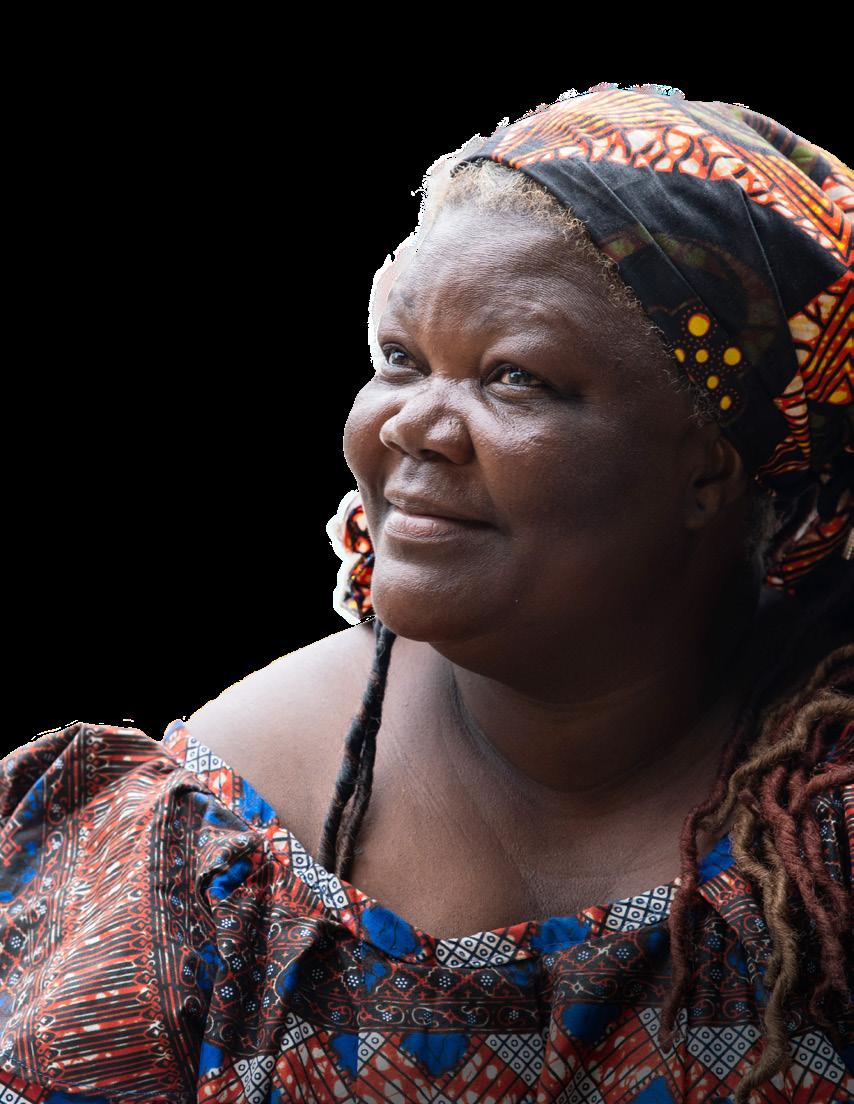

Our vision is a world in which all people have the opportunity to achieve a life free from poverty, with dignity and purpose.

For over 50 years, Opportunity International has been steadfast in our mission, transparent about our work, and relentlessly committed to our clients. This dedication, focused on two simple goals, has earned us the trust of donors, partners, and the 250 million people we have reached:
1. Equipping families living in poverty to have the financial resources and the skills they need to build sustainable livelihoods and progress out of poverty
2. Increasing the availability of affordable and accessible quality education for the children of families living in poverty
Our industry has evolved at a tremendous speed, but Opportunity has remained focused on these dual goals. With our eye on sustainable livelihoods and education, we have moved down the economic pyramid to deliver best-in-class financial solutions, technology, and training to those living in poverty, extreme poverty, and even ultrapoverty. In doing so, we have bucked the evolutionary trends of the industry, which has become largely focused on commercial returns and finding ways to de-risk.
For five decades, our “what” has not waivered—but our “how” has shifted, again and again, in favor of constant improvement, innovative solutions, and maximized impact.
For example, our local Financial Institution partner model has become increasingly effective over the last five years. Where we once saw 5:1 leverage of donor dollars catalyzed into financial resources for the families we serve, we now achieve 10:1 (and in some instances, much higher) leverage. As a result, in 2022, Opportunity and our 105 partner financial institutions released $2.6 billion to help 18.7 million lowincome clients build and improve small businesses and local schools. This innovative model enables us to move down market with more leverage, less risk, and more money released than ever before.
In addition, we are a listening organization—so we spend a great deal of organizational energy on data. We learn about the people we are reaching. We research the activities our staff perform. We measure the outcomes of the services we provide. And of course, we track the difference we are making for those we exist to serve.
This Impact Report is Opportunity’s latest effort to share both our work and our impact with you, our stakeholders, investors, and community. It’s a more robust report than we have published in recent years, and it tells you a great deal about our global efforts to be significant contributors to the U.N.’s Sustainable Development Goals.
It’s also designed to be a living document—one that will grow and iterate over time as we learn from our programs and continue to improve our reporting. We plan to release this report annually, and we aim for it to get better and better as we go.
While data is necessary, useful, and, indeed, powerful, I always come back to the most fundamental question: are we achieving our goals of building livelihoods and improving access to education, and are both of these moving our clients up and out of the poverty that has trapped their families for generations?
This is true impact—and this is why we do what we do.
As you read this Impact Report, my hope is that the data illuminates our focus, our commitment to innovative solutions, the power of partnerships, and, most importantly, the lives we transformed.
Sincerely,
Atul Tandon Chief Executive Officer Opportunity International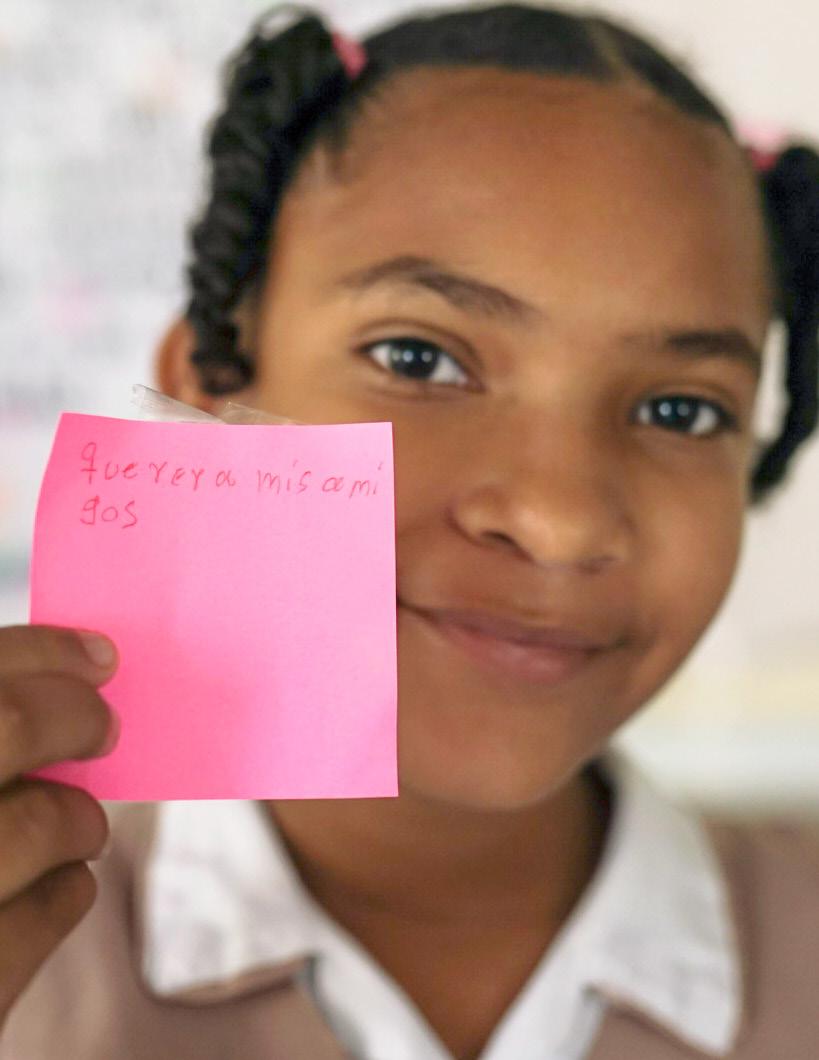

“Love my friends”
How
At Opportunity International we strive for people to have more income, fostering economic development while helping to tackle poverty and exclusion around the world and across generations. We support families living in poverty and those systemically marginalized from the traditional economy (such as women, youth, and refugees) to build resilient livelihoods by providing knowledge and training to improve skills and capacity as smallbusiness owners. We supplement this support with better access to financial services to grow their income-generating potential while broadening the range of economic opportunities available. We believe that enabling individuals to create dignified and sustainable work is the foundation for transforming their lives, their children’s futures, and their communities.
Opportunity International articulates its interventions through research- and impact-driven programs intentionally designed to tailor financial products, services, and training in sectors proven to be of high-impact toward poverty alleviation, such as agriculture, education, health, and inclusive banking and digital financial services.


Our programs enable the communities and individuals we support to develop their businesses and insure against an uncertain future. We create partnerships with local financial institutions in developing economies to help them provide innovative financial solutions that give people living in poverty choice, agency, and financial freedom. This allows us to influence capital to flow towards where it is most needed.
As we continue to collect data and expand our understanding of what is needed to deliver positive change in the future, we will review our project strategies and intended outcomes to ensure they reflect the most effective ways to achieve impact.








NO POVERTY
ZERO HUNGER
GOOD HEALTH AND WELL-BEING
QUALITY EDUCATION
GENDER EQUALITY
DECENT WORK AND ECONOMIC GROWTH
REDUCED INEQUALITIES
RESPONSIBLE CONSUMPTION AND PRODUCTION
CLIMATE ACTION
PARTNERSHIPS FOR THE GOALS

$2.7 billion 18.7 million FIPs Total number of Financial Institution partners
Total Capital Catalyzed to sustainably serve the financial needs of low-income populations
Unique Clients
97 %
Women Clients % of people reached that are women
105 SDGs No. of Sustainable Development Goals addressed

10 Jobs Created through Opportunity International’s programs and partners1
1.9 million 8.4 million
MSMEs Supported Total number of Micro, Small and Medium-size Enterprises supported globally2
1 This estimate includes jobs created through the AgFinance, EduFinance, and Microbanking programs. Further details on the methodology can be accessed in the appendix.
MCHINJI, MALAWI Over 75% of Malawi’s population live on less than $1.90 a day, making it one of the lowest-income countries in the world. 80% earn their living or subsist through agriculture, which make the country especially vulnerable to the effects of climate change.
Our new three-year project, Strengthening Systems for Financial Inclusion in Rural Malawi aims to improve the livelihoods of over 24,000 underserved people living in rural areas. We will provide training and support for clients to adopt sustainable farming methods that build resilience in farming communities, particularly against the impacts of climate change. We will recruit local farmers to deliver this training in their own communities, thereby embedding knowledge for years to come.
Florence, a soya, groundnut, and maize farmer in Malawi, with two of her grandchildren.
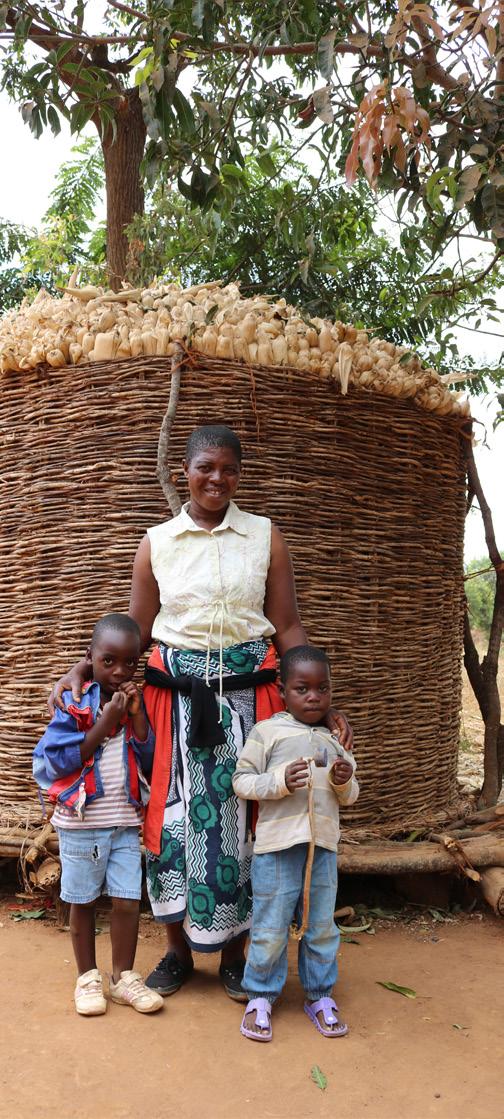
GUATEMALA*
HONDURAS*
NICARAGUA
HAITI
DOMINICAN REPUBLIC
SENEGAL*
SERBIA
LIBERIA*
GHANA
EL SALVADOR* NIGERIA
ECUADOR*
COLOMBIA PERU*
PARAGUAY*
DEMOCRATIC REPUBLIC OF THE CONGO
ZAMBIA*
ZIMBABWE*
UGANDA
RWANDA
PAKISTAN*
ETHIOPIA*
KENYA
TANZANIA*
MALAWI MOZAMBIQUE MADAGASCAR*
PHILIPPINES CAMBODIA*
Today, Opportunity International works in 33 countries, partnering with experienced in-country partners to support millions of people in building sustainable livelihoods. These countries represent 35% of the world’s population and host approximately 76% of people living under $2.15 per day.
*EduFinance presence onlyTeachers at low-cost, non-government schools have diverse educational backgrounds and may have limited access to professional training. To address this, teachers attend EduQuality Teacher Mentor Trainings led by an Education Specialist and later deliver it to their peers—like these teacher mentors in Uganda.
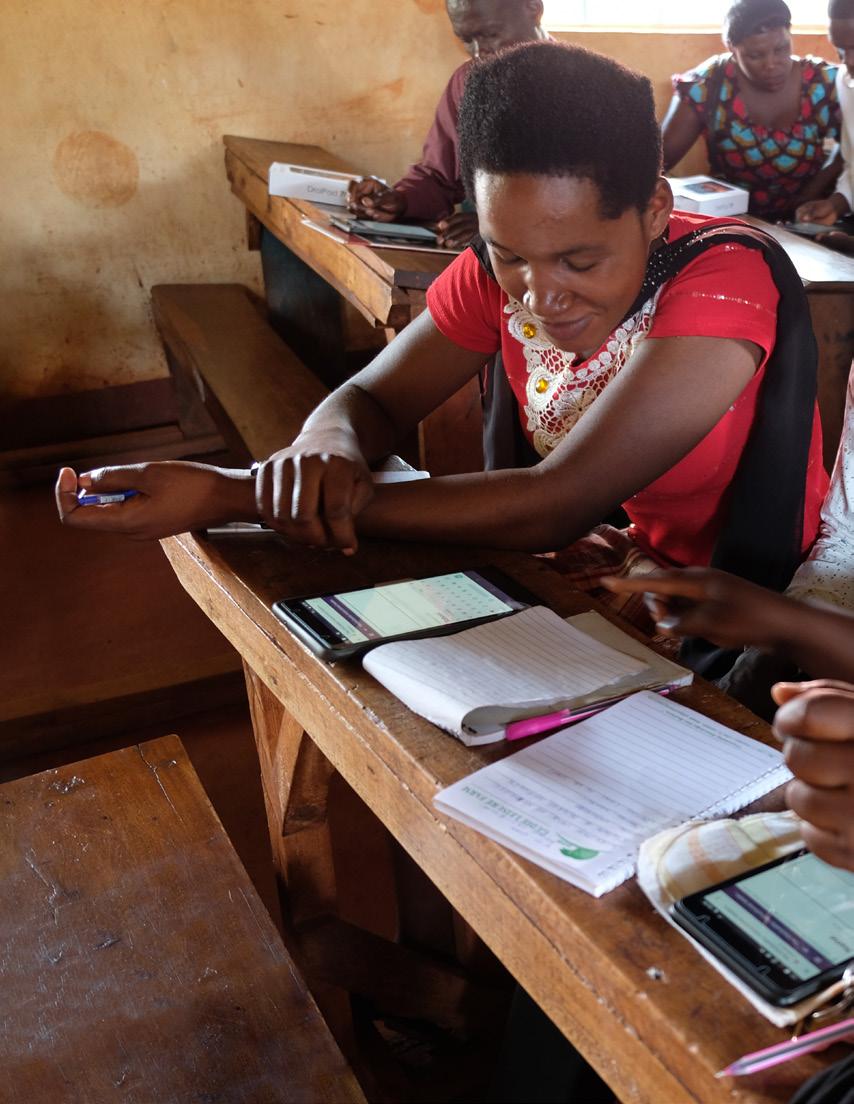
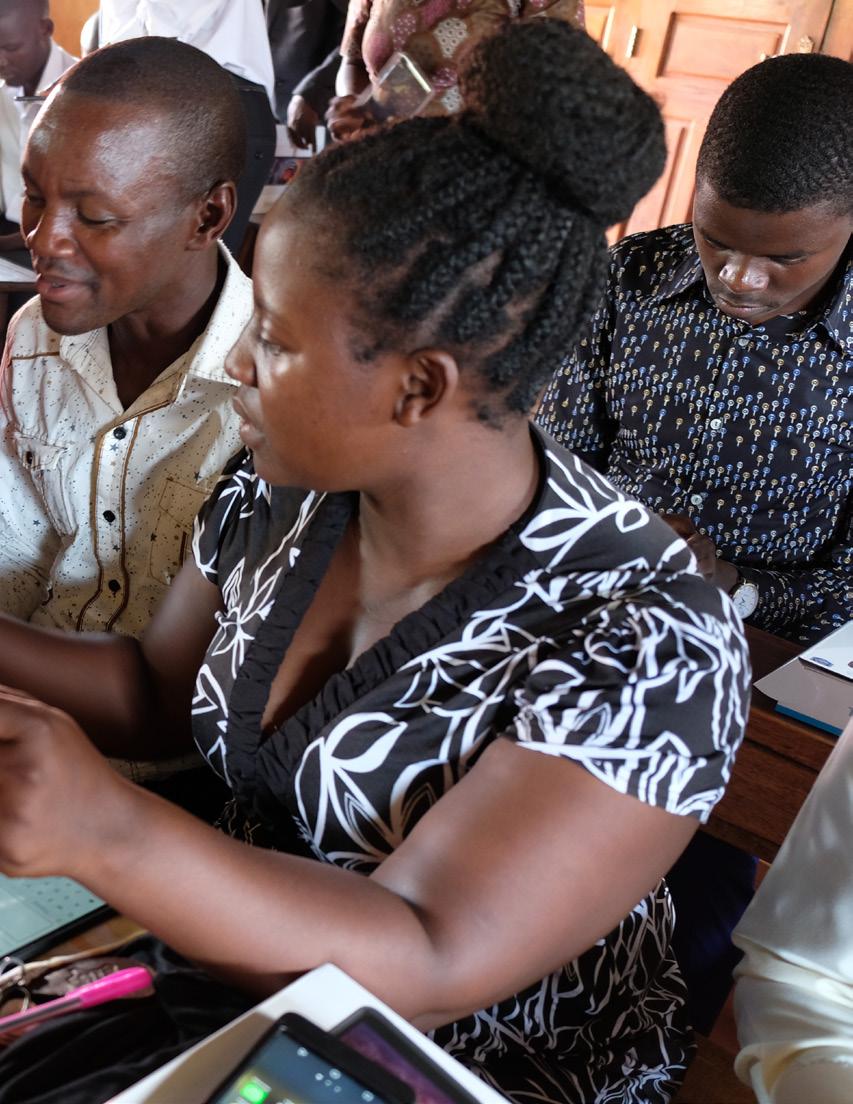
For a child growing up in poverty, more time spent learning in a classroom directly translates into better outcomes in every facet of life. Every $1 invested in an additional year of schooling yields $10 in benefits for low-income communities.3 Yet, 244 million children across the globe don’t go to school. Of those who do, 361 million lack basic literacy and numeracy skills. With governments unable to meet the demand for education, non-government schools play an important complementary role in low and middle-income countries. As of 2020, nongovernment schools comprised more than 1 in 4 schools globally—the majority of which are owned and operated by local entrepreneurs.4 While access to non-government schools varies by socio-economic background, even children from the lowest-income households attend these schools.
Education is a priority for us given its importance to improving the livelihoods of our clients and their families today and its role in fostering long-term development and combating intergenerational poverty. We have pioneered the provision of Education Finance (EduFinance) to low-cost, non-government schools5 since 2009 when we gave the first of our EduFinance loans. Since then, over $541 million has been disbursed by local financial institutions globally towards education loans with our support.
Our EduFinance team partners with local financial institutions to mobilize capital for school owners to fill in short-term funding gaps so that, for example, teachers are always paid on time. EduFinance loans also support longer-term investments such as
3 The International Commission on Financing Global Education Opportunity, 2019. The Learning Generation: Investing in Education for a Changing World. 4 The State of the Affordable Non-State School Sector (4th ed.). https://edufinance.org/ publications/affordable-non-state-school-report 5 Opportunity International works with private schools that, on average, charge less than US$30 per month in fees to serve lowincome families in their neighborhood.in school infrastructure, teaching equipment, and school buses. Our School Improvement Loan clients are most often local women educators or entrepreneurial parents who have started an affordable private school and have achieved sustained enrollment rates for at least two years.
We also work with the local financial institutions to encourage education loans for parents to ease cash flow constraints in families, so they can pay the school fees and any additional costs for learning materials.
Beyond the access to formal education, the quality of education delivered is critical for impact. Hence, we foster an enabling environment for learning through our holistic three-year EduQuality Program. The program is based on a proprietary self-assessment tool used by school leaders to, first, diagnose the quality of the school and then create and implement school development plans. EduQuality interventions are delivered through a blended learning model that combines digital, self-access content on tablets for school leaders and teacher mentors with interactive in-person training and support.
We are committed to better understanding and learning from the impact of our EduFinance program. Early evidence suggests EduFinance has the potential to improve access to and quality of education for learners from low-income backgrounds. To further validate this, we are conducting an industry-leading randomized control trial to understand the impact of EduFinance on student learning outcomes in Kenya and to identify the largest drivers of learning outcome improvement, e.g. credit access (school loans) or professional development (quality education).
BOGOTÁ, COLOMBIA Liceo Cristiano mi Refugio Perfecto first opened its doors in Colombia in February 1996 with only five students. Today the school has grown to 364 pre-primary and primary learners and won the 2021 Colombia EduQuality Award in recognization of the school’s efforts to improve the protection and safeguarding of these young children.
School Director Damaris Ester Rojas
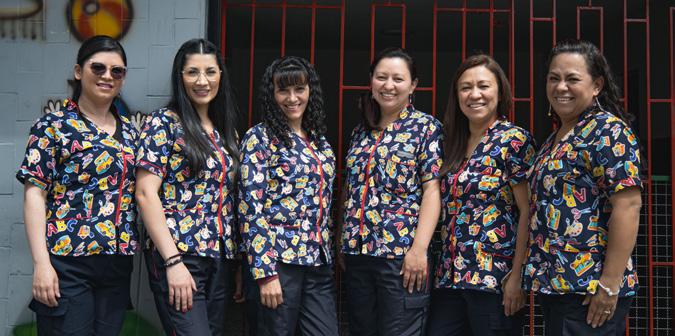
Bravo made the decision to join the EduQuality program in 2019 and currently serves as the “Generators of Change” cluster leader, helping her peer school leaders to work collaboratively, share experiences, and find creative solutions to improving their schools.
After identifying the school’s low score in the area of child protection and better understanding the importance of child protection to learners' overall wellbeing, the school prioritizes this in their annual development plan. School leaders took steps to engage and educate the entire school community—including staff, students, parents, and teachers—on the fundamental rights of all children to be in a safe learning environment. Leaders also implemented ongoing awareness raising activities, and used Family Days at the schools to continue emphasizing the duty of care the school has to its learners.
sdg 1
No Poverty
Targets 1.1, 1.2, 1.4, 1.5
sdg 2
Zero Hunger
Targets 2.1, 2.3, 2.4
sdg 5
Gender Equality
Target 5.1
sdg 8
Decent Work and Economic Growth
Targets 8.2, 8.4, 8.10
sdg 10
Reduced Inequalities
Target 10.2
sdg 12
Responsible Consumption and Production
Targets 12.2, 12.4
sdg 13
Climate Action
Targets 13.1, 13.3
Smallholder farming is complex and unpredictable, yet it is a lifeline for two-thirds of families living in poverty. Our Agriculture Finance (AgFinance) program seeks to end the cycle of lowproductivity farming in rural African communities. We provide farmers with training on best practices in farming, improved access to markets for inputs and buyers, and where feasible, access to targeted financial services delivered by our partner financial institutions. These programs help rural families increase agency and transform their small farms into more productive, lucrative, and effective enterprises. As an example, a survey in Ghana among our partner Opportunity International Savings and Loans showed that borrowers engaged in productive activities hired, on average, 8.9 workers.
We have been at the forefront of agricultural finance since 2008, designing a wide range of financial products for rural communities, including production loans and rural savings accounts, Micro, Small, and Medium-size Enterprises loans for agribusiness, loan guarantees, mechanization loans, post-harvest loans, and revolving credit facilities. For farmers in extreme poverty, we have built localized networks of Farmer Support Agents (FSAs), local leaders who deliver digital training, facilitate access to markets and support services to improve the health of their land, effectively cultivate their crops, and increase their harvests.
Gender inequality in agriculture comes through internal and external constrains to reaching women which includes mens'
dominance in farming and business, limited access to land rights, unpaid work and poor employment conditions. By influencing and helping Financial Institution partners to better understand and meet the demand of their women clients, AgFinance reduces the risk and enhances the business case for finance to smallholders, especially women, further contributing to the sustainability and expansion of inclusive financial services in Africa.
Over the last fiscal year, we helped more than 156,600 households in sub-Saharan Africa to build resilient livelihoods for themselves through small-scale farming. 56% of farmers served were women. Overall we disbursed 45,700 loans totaling $50.9 million. Since we started our AgFinance program in 2008, we’ve helped 739,700 households to access the resources they need to grow and improve their farms, by dispersing over 628,800 loans totaling $277.9 million.
We want to push the boundaries in measuring impact by developing methods to collect data on:
u Resilience – the number of income streams clients have.
u Jobs – the number of jobs created and sustained in farming.
u Nutrition – the number of household meals a day as well as the diversity of nutrition base at home.
In 2023, AgFinance will continue to expand its geographic footprint, with new programs established in Nigeria and Colombia.
AgFinance will also launch a revised, comprehensive strategy on SDG 13 focused on climate resiliency and adaptation. This is a big step forward, allowing the program to target the intersection of smallholder farmers, regenerative agriculture practices, and gender. We plan to mobilize impact investors, institutional supporters, and private donors to the cause.
ZOMBA,
A high-touch, high-tech, high-impact approach to agricultural finance enables expansion of financial service markets to people facing poverty, gender, and age barriers to economic empowerment.8
At the center of the model are community-based farm advisers, providing high-touch, high-tech training in financial management, good agricultural practices, inclusion, and resilience. They also link farmers to financial service providers, input and equipment suppliers, and markets.
In Malawi, where Opportunity has applied this model, 72% of clients were living in extreme poverty, 57% were women and 40% youth. In 2021, the AgFinance program facilitated loans to 68,262 borrowers with an outstanding balance of $24.82 million. This outreach and scale demonstrates a market systems model—the high touch, high tech, high impact approach—with deep outreach at scale.
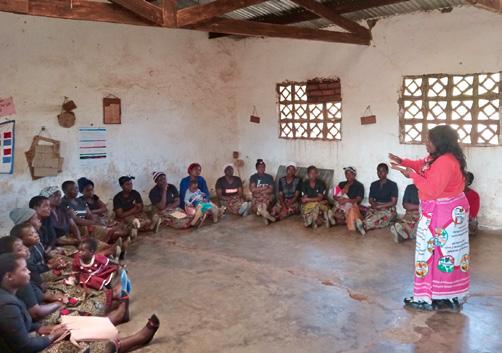 MALAWI
8 McVay, M., Yamamoto, G., Strong, T., Ndoka, E., Coulson, L., & Awuah, L. S. (2022). Agricultural finance that reaches people facing poverty, gender, and age barriers. Enterprise Development and Microfinance, 33(1), 45–58. https://doi.org/10.3362/1755-1986.21-00038
MALAWI
8 McVay, M., Yamamoto, G., Strong, T., Ndoka, E., Coulson, L., & Awuah, L. S. (2022). Agricultural finance that reaches people facing poverty, gender, and age barriers. Enterprise Development and Microfinance, 33(1), 45–58. https://doi.org/10.3362/1755-1986.21-00038
sdg 1
No Poverty Targets 1.1, 1.2, 1.4, 1.5
sdg 5
Gender Equality
Targets 5.1, 5.2, 5.b
sdg 8
Decent Work and Economic Growth
Targets 8.2, 8.10, 8.6
sdg 10
Reduced Inequalities
Targets 10.2, 10.1
Globally, 61% of the global population works in the informal economy, 1 in 3 don't have a bank account, and 1 in 10 still live in extreme poverty. Marginalized communities, such as women, refugees, and people with disabilities, are particularly overlooked by existing financial institutions and systems. The lack of financial resources, professional networks, and business management skills limit the options for these populations to secure sustainable livelihoods and jobs.
Opportunity International was one of the first organizations to address this need. We pioneered Microbanking for people living in extreme poverty—with a particular focus on removing barriers and perceived risk from our target clients. Today, we partner with financial service providers to offer innovative financial services (such as tailored loans and microinsurance) and training (such as financial literacy training for entrepreneurs) to help entrepreneurs and small business owners grow their businesses, become economically empowered, and enable them and their families to thrive.
Through its Microbanking program, Opportunity fosters the provision of financial services to marginalized communities in two main areas. First, we engage partners on program and financial product designs as well as guarantees to provide micro-loans so clients can start and grow small businesses over time. Second, we collaborate with our partners to help
our clients build resiliency through flexible individual or group savings accounts. Given the challenges facing the communities we serve, and the complexity of poverty, it takes time for clients to build their resilience, but our financial services are vital instruments in this process. Through our high-touch, high-tech approach, we connect people to the tools and training they need to build bright futures for their families.
Many of the communities we serve were severely impacted by the COVID-19 pandemic, particularly in relation to their financial and business needs, further demonstrating the importance of building resilience in these communities. Asia and Africa comprise a large proportion of our Microbanking client base, so it’s imperative that we continue to deliver our comprehensive services. We delivered financial services, training, and support with 20 financial service partners reaching over 18.7 million people with loans and savings. 97% of loans went to women. We released over $2.6 billion in funds supporting our partners and delivering vital, sustainable microloans to 8.4 million clients. Further, 16.3 million clients were able to save some money, even if small, to safeguard the future for themselves and their families.
We plan to increase the reach of our services to those living in extreme poverty, so that the most vulnerable communities have access to financial services and begin to build their financial resources.
We also aim to push the boundaries in measuring our impact and take our data collection further in the following areas:
u Resilience – the number of income streams clients have.
u Management – clients’ knowledge and confidence in managing their financial resources.
u Jobs – the number of jobs created and sustained in small businesses and enterprises.
UGANDA Women are essential to the global economy and to breaking the poverty cycle. Yet, research by International Trade Centre (ITC)11 reveals only one in five exporting businesses are owned by women and there is a $300 billion financing gap for women entrepreneurs in developing countries.
To help meet this need, Opportunity International is working with UPS and ITC through the SheTrades program to deliver financial services, managerial capacity, and market linkages for women. The program launched in 2020 in Uganda, and by the end of the year had distributed loans to 2,439 women to grow their export business, doubling our target. 1,145 women have enrolled in the SheTrades platform and the program has impacted over 113,000 lives—including Jessica who was able to secure a low-interest $8,000 loan in 2020 to grow her events and decoration business with plans to open an office in a neighboring district. With the success in Uganda, we plan to scale the program to two new markets: Colombia and Ghana.

sdg 1
No Poverty
Targets 1.1, 1.2, 1.4
sdg 5
Gender Equality
Targets 5.1, 5.b
sdg 8
Decent Work and Economic Growth
Targets 8.2, 8.10
sdg 10
Reduced Inequalities
Target 10.2
sdg 17
Partnerships for the Goals
Target 17.8
An estimated 80% of people living in extreme poverty live in rural regions, primarily in sub-Saharan Africa and parts of Asia, where low population density and poor infrastructure make it difficult for people to access financial services if they’re using a traditional brick-and-mortar model. Technology is vital to reaching and serving these populations sustainably and bringing the most marginalized groups—primarily women—into financial inclusion.
14 Derban, W. (2023, November 23).
The Power of Trust in Digital Finance: How to Leverage Trusted Technology to Maximize Inclusion and Impact. NextBillion. https://nextbillion.net/trust-digital-financetrusted-technology-inclusion-impact/
When it comes to developing trusted technology that can bridge the digital divide, the Digital Financial Services (DFS) program works with a subset of our Microbanking partners and focuses on two concepts that ensure that people living in poverty have access to products and services tailored to their needs and budgets. The first and most important concept is human-centered design— a technique that puts real people at the center of the product design process. This approach helps us determine how we can best serve the world’s most impoverished people in new ways using new technologies. The second concept we’re exploring is the cost to serve. For people living in poverty to gain access to—and build trust in—technology solutions, they must be affordable, both at the client and institutional level. When tech solutions reduce the cost to serve people living in poverty, those solutions can be offered at a lower price and scaled to their benefit.14
A central pillar of our work is creating digital pathways for women’s economic empowerment. Identifying the barriers to women engaging in digital finance helps us to support our financial institution partners to better engage clients through
digital services. For example, we have researched in-depth the needs and hesitancies of women, so we can provide specific training to directly address technological barriers for women.
A total of 251,000 clients used digital financial services,15 of these clients, 58% were women. A total of 3.3 million digital transactions were made, at an average value of $67.
The work of digital solutions to accelerate financial inclusion and job creation is moving forward with momentum. In India, 1,000 existing female banking agents were trained using an apprentice-assisted and online platform, with a further 2,000 being prepared for a self-directed training online.
We’re continuing to work with financial institutions and informal savings groups to build data-informed business practices. Data from digital transactions, mobile phone usage, and savings behavior can help direct changes to digital products and strategies to further improve digital services for clients. Using high-touch, high-tech solutions like agent banker networks and mobile banking, we provide reliable financial services at reduced cost to more clients who have previously been excluded from formal financial services.
15 Complete Digital Financial Services data across all partners available in 2021 currently.THRISSUR, INDIA By helping financial institutions build women-focused agent networks, more women are able to connect digitally to their bank accounts. Our agents operate in rural communities and are trained and supported by financial institutions to accept cash deposits and withdrawals on behalf of the bank.
Renju (above, right), is an agent banker in Thrissur, India. Renju travels around on her moped and serves more than 900 women in the local area. These women spend their weeks managing their small businesses
and providing for their families, saving what earnings they can. Renju offers them much-needed access to financial services that they would not otherwise have access to, due to the distances they have to travel.
Renju uses her tablet to verify identities using an iris or a fingerprint scan. The transaction is logged digitally, and an SMS alert is sent out verifying that the deposit has been accepted and processed. With a trusted local woman as the agent, women clients are often much more at ease conducting digital transactions.
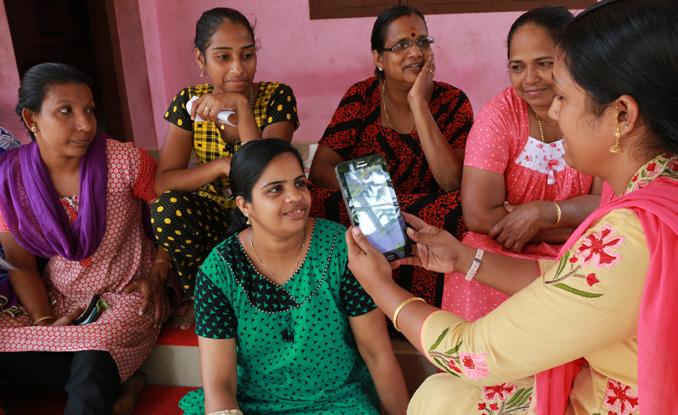
As an agile organization, we build targeted programs to create a deep impact on the socio-economic issues that affect our clients in specific places. Importantly, Opportunity has initiated a program targeting the integration of health and microfinance. We see access to community-appropriate health services as a natural extension of a microfinance institution's (MFI’s) mission of financial security and social protection of the client, improving productivity and household resilience.
Our Health and Women’s Safety program in Asia (India, Bangladesh, Indonesia, and Nepal) focuses on empowering women by addressing domestic violence and providing basic health education. COVID-19 deepened inequalities, but even before the pandemic, women in low-income communities faced immense challenges in accessing quality, affordable healthcare. Hence, for the majority of 2021, our health program was focused on supporting communities to prevent, treat, and vaccinate against COVID-19.
We’re enhancing our Health program to better serve low-income families through three flagship initiatives: Health Leaders, Health Entrepreneurs, and Health Finance. These three initiatives work in tandem to improve access to last-mile primary healthcare, supporting the communities we serve to seek, reach, pay for, and engage actively in their health and wellbeing.
Our health program will continue to grow in reach and depth of impact as we prioritize primary healthcare access in rural and remote areas, including diagnostic tools and chronic disease medications.
Our programs across Asia reached over 18 million people and vaccinated over 6.4 million people.
Our community Health Leaders initiative has been especially successful, engaging over 1,900 leaders across Asia, including 1,200 Health Leaders in India. Our Health Leaders were able to serve 1.2 million people in 2021.
*1,200 existing Health Leaders were engaged in the COVID-19 response
We will continue to leverage our industry-leading microfinance networks to increase uptake of health savings and health insurance options, improving the resilience of the families we serve through our new Health Finance program, starting in 2022 in India.
BANGLADESH Kulsum is a mother of an 8-year-old boy and is pregnant with her second child. With her first pregnancy, Kulsum was not aware of services available to her; she didn’t know about how to stay healthy during pregnancy, birth plans, postpartum, or newborn care.
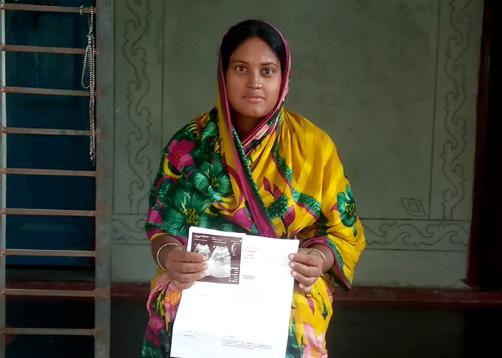
Since being in contact with a Health Educator, Kulsum now has a birth plan, has her hospital visit arranged in readiness for the delivery, and understands the need to rest and take care of her health during her pregnancy. She feels much more confident this time around and has also been educated about birth control following the birth of her baby.
“I came to know about all these things through the training of the Basic Health Education Program,” said Kulsum.
We have been investing for impact since we were founded over 50 years ago. We were the first nonprofit organization to recognize the benefits of offering financial services for people living in poverty in developing countries. We are an investor in four financial institutions, and since 2008, we have supported Dia Vikas, an India-focused social microfinance fund filling the gap of social investment in the Indian microfinance sector, by supporting the growth and development of Financial Institutions in underserved regions. Opportunity believes that our ownership allows us to be more innovative and risk-taking in meeting the needs of our target communities.
Today, in addition to leveraging philanthropic capital, we partner with impact investors to attract investment capital to generate measurable social or environmental impact alongside a financial return. With over a trillion dollars committed to the impact investing industry in 2022,16 we aim to attract more impact investors as allies for our programs, given our position as global leaders in using innovative financial mechanisms to lift people out of poverty.
Based on the lessons learned as risk-takers in developing countries, Opportunity is actively seeking to partner with catalytic capital providers and impact investors who are focused on reaching people in poverty through supporting marketbased solutions. We believe that comprehensive interventions and designs combining impact capital with credit support and other forms of catalytic capital could meaningfully increase the capital flows to the communities we want to serve.
16 Hand, D., Ringel, B., Danel, A. (2022) Sizing the Impact Investing Market: 2022. The Global Impact Investing Network (GIIN). New York.Hilton Junior Day & Boarding Primary School in Uganda started with 15 boarders in 2007 and now has 1,000+ students and 52 staff. School Improvement Loans enabled them to expand their grounds and build new facilities, such as girls bathrooms, dormitories, and this assemly hall, which will be used for dining and community events when completed.
In 2022 we partnered with Oikocredit, a social impact investor and global cooperative promoting sustainable development through investments, to increase access to and quality of education in low-income countries. Through our partnership, Oikocredit will invest up to $100 million in financial institutions who are benefiting from our EduFinance program, reaching an estimated 1.6 million children.
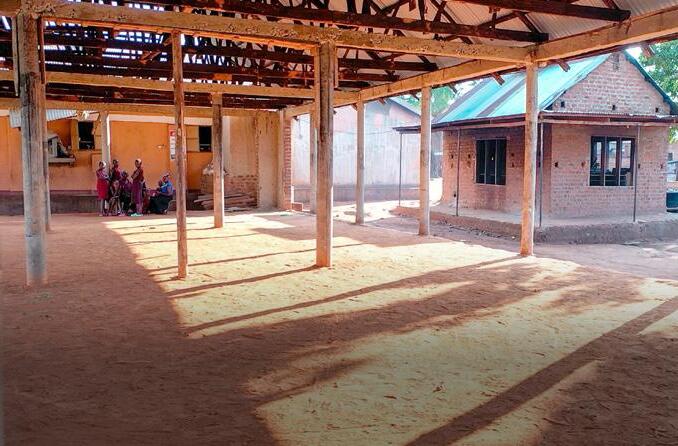
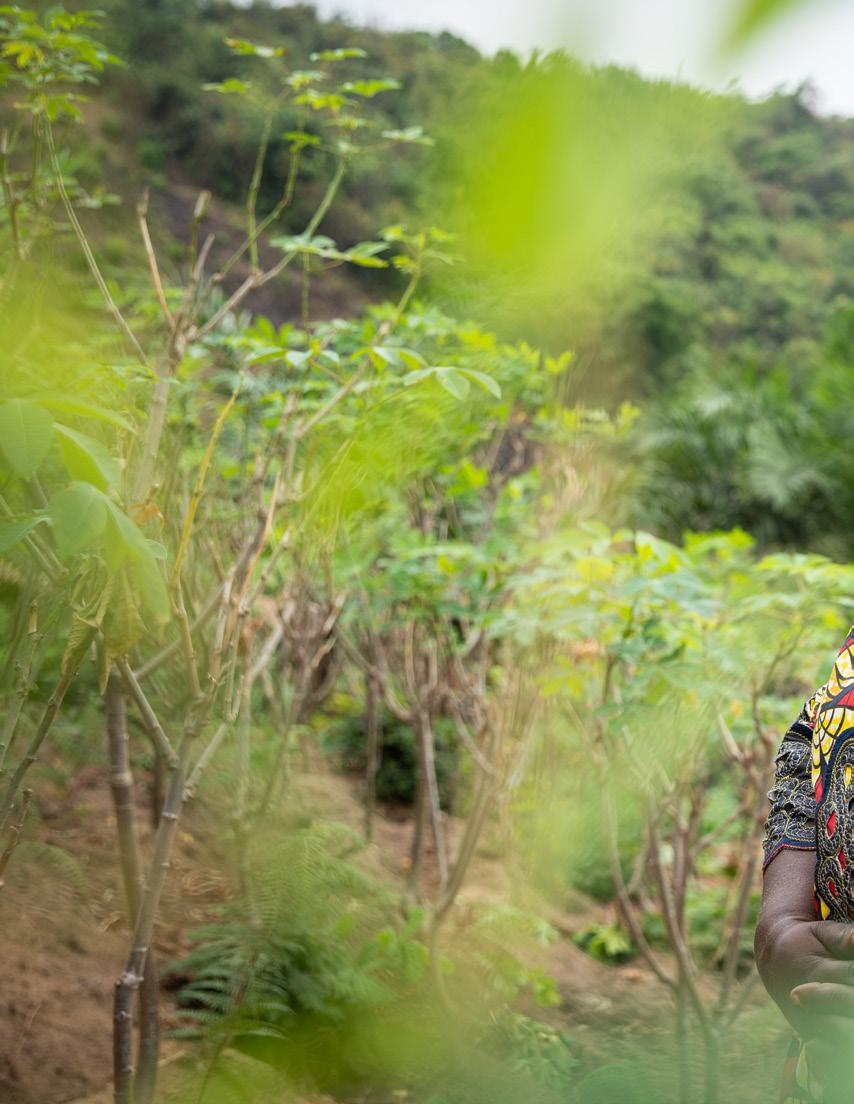
“With this project I’ve been able to pay for school fees for my first born, she’s going on a trip to Cyprus soon to further her studies.”
Chantal tends to her cassava plants at her farm in Kinshasa, Democratic Republic of the Congo.
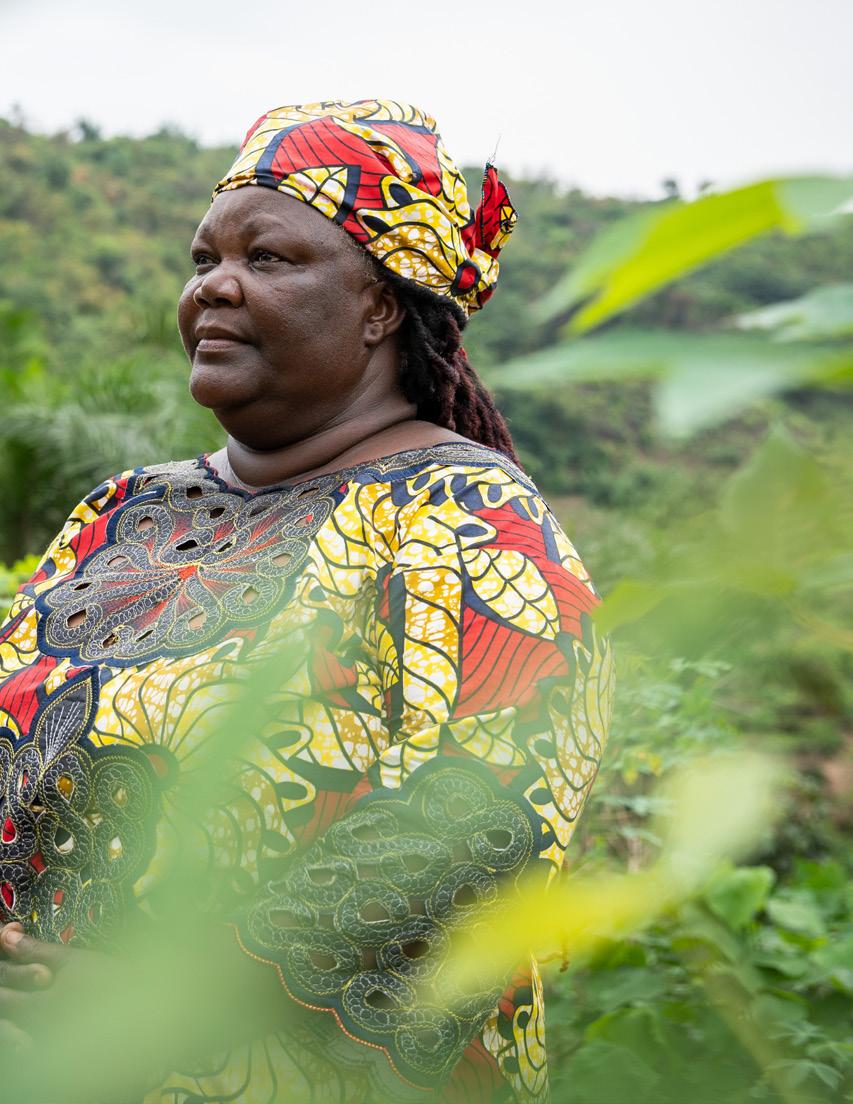
Since 2012, we have been implementing Social Performance Management (SPM) as part of our new strategic plan. We are at the vanguard of the industry in utilizing SPM to measure how to achieve social goals and to identify areas where we can improve social outcomes for our clients.
Through SPM, we are expanding our data collection on who we serve and how their lives are changing. We analyze this data to assess how well we are aligned in our mission and how we can perform even better.
In line with the rest of the industry, we’re committed to contributing towards the U.N. Sustainable Development Goals. We regularly map our initiatives against these goals to ensure we are aligned and will continue to report against them.
Opportunity International Inc. is incorporated in the United States of America, it implements the Education Finance program in 33 countries, and, along with
Opportunity International Australia, is part of the broader Opportunity International Network. Opportunity International Australia provides funding to support the Education Finance program in Asia.
Opportunity International Australia implements the Health and Women's Safety programs.
Opportunity’s Health and Women’s Safety programs are supported by the Australian Government through the Australian NGO Cooperation Program (ANCP).
Opportunity International Australia is a majority shareholder of Dia Vikas. Opportunity International Inc. is a minority shareholder of Dia Vikas.
Network Includes:
Opportunity International Australia
Opportunity International Canada
Opportunity International Germany
Opportunity International UK
Opportunity International US
GLOBAL IMPACT DEFINITIONS
Total capital catalyzed: Total value of loans made by Opportunity’s Financial Institution partners across EduFinance, AgFinance, and Microbanking programs globally.
People reached: Savings clients from Network FIPs, children reached through EduFinance,
people reached in AgFinance, and the number of other clients reached through other programs and grants (NicaCED, Fonkoze graduation, McConnell impact study, Opportunity International Malawi FARMSE, Amway Power of 5, AGAPE, and Gemena Zone).
% of people reached that are women: Percent of people reached from MSME and AgFinance that are women.
Total number of financial service partners: Number of unique financial institutions and NGOs engaged with MSME, AgFinance, and EduFinance.
Jobs created through Opportunity’s programs and partners: The total number of jobs created from EduFinance, AgFinance, and loans to MSME owners (Microbanking). See each program’s definitions for further detail.
Value of loans provided to schools and learners: Value of loans disbursed during the year by Financial Institution partners or all EduFinance products, including loans to school proprietors and to parents for school fees.
No. of children reached by EduFinance: Aggregate number of children either attending the schools financed through EduFinance loans or number of children accessing School Fee Loans.
No. of jobs created by EduFinance loans: Estimated aggregate jobs created for all schools accessing EduFinance loans in the reporting
period. This estimate is based on assumptions around direct job creation at each school (proprietor, active teachers, new teachers) that were derived from a study done by Opportunity on a cohort of borrower schools in 2016.
No. of schools financed: Schools receiving School Improvement Loans (SIL) or Tertiary Institution Loans (TIL) during the reporting period.
Student loans disbursed: Number of loans disbursed by FIPs to individuals for School Fee Loans (SFL), Tertiary Tuition Loans (TTL), Teacher Loans (TL), and Vocational Loans (VL) during the reporting period.
Financial Institution partners (FIPs): Number of FIPs actively partnering with EduFinance as of the end of the reporting period through technical assistance or portfolio lending.
Schools participating in EduQuality: Number of schools actively participating in Opportunity’s EduQuality program as of the end of the reporting period.
% of schools in EduQuality reporting improvements: Percent of schools engaged in EduQuality over 12 months reporting improvements in Opportunity’s Pathways to Excellence (P2E) selfassessment scores. More details on our EduQuality program can be accessed here: https://edufinance. org/what-we-do/education-quality.
The percentage of total value of outstanding loan balances for which there has been no activity
on the account in the last 30 days, compared with the total EduFinance loan portfolio.
Usage of school finance loans: Potential areas where EduFinance loans taken by school proprietors are deployed. This data is currently not reported systematically across the portfolio. The figures reported here are estimates based on the findings from third-party assessment of EduFinance clients in Ghana and Uganda, 2019. https:// opportunity.org/news/publications/ knowledge-exchange/school-loanspositive-outcomes
Value of loans provided to farmers: Value of agriculture loans disbursed during the year for all AgFinance products.
Households reached YTD: Number of households and agribusinesses who received financial services (loans and/or training) during the reporting period.
No. of jobs created by AgFinance: The number of jobs created through loans to support agriculture and farming businesses. Each loan represents one farmer whose job is supported, combined with 0.2 fulltime equivalent (FTE) employees supported by the farmer. This multiplier is based on survey results from 2021 indicating that 1 job is created for every 15 loans.
% of clients that are women: The percent of farmers receiving loans or served by FSAs that are women.
Farmer loans disbursed: Number of agriculture loans disbursed to
farmers during the reporting period across all AgFinance products.
Farmer Support Agents (FSAs): Number of active agents delivering trainings to smallholder farmers within the reporting period.
Farmers supported by FSAs: Number of farmers trained, profiled, or supported by FSAs.
% of new farmers supported by FSAs living in extreme poverty: Percent of new farmer clients living under $1.90 per day according to Progress out of Poverty Index (PPI).
Financial Institution partners: Number of financial institutions with signed partnership agreements as of the end of the period.
Loan Portfolio At Risk (PAR30): The percentage of total value of outstanding loan balances for which there has been no activity on the account in the last 30 days, compared with the total AgFinance loan portfolio.
Total value of loans made by Opportunity’s partners: The value of loans made during the reporting period by Financial Institution partners.
Financial Institution partners: Number of Opportunity’s Financial Institution partners that deliver loans and savings services to clients.
No. of jobs created through loans to support MSME owners: The number of jobs created through loans to support MSME owners. Each loan represents one business owner whose jobs is supported, combined
with 0.067 full-time equivalent (FTE) employees supported by the business owner, based on research conducted in 2010.
No. of clients with loans: Number of borrowers during the reporting period.
% of clients with loans that are women: Percent of clients with loans that are women at the end of the period.
% of clients with loans from rural areas: Percent of clients with loans that are from rural areas during the reporting period, based on data from 80% of all loan clients globally.
Average loan size: The total value of loans made by Opportunity’s partners by the number of clients with loans for the reporting period.
Loan Portfolio At Risk (PAR30): The percentage of total value of outstanding loan balances for which there has been no activity on the account in the last 30 days, compared with the total loan portfolio.
No. of clients with savings accounts: Number of depositors in Africa, Latin America, and Serbia plus number of voluntary depositors in Asia at the end of the period.
% of clients with savings that are women: Percent of clients with savings accounts that are women at the end of the period.
% of clients that reported business income increasing because of Opportunity: Percent of survey respondents that reported a significant or slight increase in business income.
% of clients that reported increase in savings balance because of Opportunity: Percent of survey respondents that reported a significant or slight increase in their savings balance.
% of clients that would find it easy to pay a major, unexpected expense: Percent of survey respondents that reported it would be very or slightly easy to face a major expense.
% of clients that report a positive change in the number of paid employees because of Opportunity (for those that have paid employees): Percent of survey respondents that reported a positive change in the number of employees they have, for those who have employees.
% of clients that reported a positive change in their ability to manage financial sources: Percent of clients that reported an increase in their ability to manage their finance.
Total number of digital transactions: Volume of all digital transactions, e.g. wallet to account, account to wallet, airtime, paybill, agent deposit, agent withdrawal, ATM deposit, ATM withdrawal, etc.
% of total transactions which are digital: Total volume of digital transactions divided by total volume of transactions.
Average digital transaction value: Average digital transaction size in USD.
No. of active women clients: Total number of active women clients.
% of active clients who are women: Percent of active women among men and women registered.
1.1 By 2030, eradicate extreme poverty for all people everywhere, currently measured as people living on less than $1.25 a day.
1.2 By 2030, reduce at least by half the proportion of men, women and children of all ages living in poverty in all its dimensions according to national definitions.
1.4 By 2030, build the resilience of the poor and those in vulnerable situations and reduce their exposure and vulnerability to climate-related extreme events and other economic, social and environmental shocks and disasters.
1.5 By 2030, build the resilience of the poor and those in vulnerable situations and reduce their exposure and vulnerability to climate-related extreme events and other economic, social and environmental shocks and disasters.
2.1 By 2030, end hunger and ensure access by all people, in particular the poor and people in vulnerable situations, including infants, to safe, nutritious and sufficient food all year round.
2.3 By 2030, end all forms of
malnutrition, including achieving, by 2025, the internationally agreed targets on stunting and wasting in children under 5 years of age, and address the nutritional needs of adolescent girls, pregnant and lactating women and older persons.
2.4 By 2030, ensure sustainable food production systems and implement resilient agricultural practices that increase productivity and production, that help maintain ecosystems, that strengthen capacity for adaptation to climate change, extreme weather, drought, flooding and other disasters and that progressively improve land and soil quality.
3.1 By 2030, reduce the global maternal mortality ratio to less than 70 per 100,000 live births.
3.2 By 2030, end preventable deaths of newborns and children under 5 years of age, with all countries aiming to reduce neonatal mortality to at least as low as 12 per 1,000 live births and under-5 mortality to at least as low as 25 per 1,000 live births.
3.3 By 2030, end the epidemics of AIDS, tuberculosis, malaria and neglected tropical diseases and combat hepatitis, water-borne diseases and other communicable diseases.
3.4 By 2030, reduce by one third premature mortality from non-communicable diseases through prevention and treatment and promote mental health and well-being.
3.7 By 2030, ensure universal access to sexual and reproductive health-care services, including for family planning, information and education, and the integration of reproductive health into national strategies and programs.
3.8 Achieve universal health coverage, including financial risk protection, access to quality essential health-care services and access to safe, effective, quality and affordable essential medicines and vaccines for all.
3.c Substantially increase health financing and the recruitment, development, training and retention of the health workforce in developing countries, especially in least developed countries and small island developing States.
4.1 By 2030, ensure that all girls and boys complete free, equitable and quality primary and secondary education leading to relevant and effective learning outcomes.
4.5 By 2030, eliminate gender disparities in education and ensure equal access to all levels of education and vocational training for the vulnerable, including persons with disabilities, indigenous peoples and children in vulnerable situations.
4.6 By 2030, ensure that all youth and a substantial proportion of adults, both men and women, achieve literacy and numeracy.
4.a Build and upgrade education facilities that are child, disability and gender sensitive and provide safe,
non-violent, inclusive and effective learning environments for all.
4.c By 2020, substantially expand globally the number of scholarships available to developing countries, in particular least developed countries, small island developing States and African countries, for enrollment in higher education, including vocational training and information and communications technology, technical, engineering and scientific programs, in developed countries and other developing countries.
5.1 End all forms of discrimination against all women and girls everywhere.
5.2 Eliminate all forms of violence against all women and girls in the public and private spheres, including trafficking and sexual and other types of exploitation.
5.6 Ensure universal access to sexual and reproductive health and reproductive rights as agreed in accordance with the Programme of Action of the International Conference on Population and Development and the Beijing Platform for Action and the outcome documents of their review conferences.
5.b Enhance the use of enabling technology, in particular information and communications technology, to promote the empowerment of women.
8.2 Achieve higher levels of economic productivity through diversification, technological upgrading and innovation, including through a focus on high-value added and labor-intensive sectors.
8.4 Improve progressively, through 2030, global resource efficiency in consumption and production and endeavor to decouple economic growth from environmental degradation, in accordance with the 10-Year Framework of Programmes on Sustainable Consumption and Production, with developed countries taking the lead.
8.6 By 2020, substantially reduce the proportion of youth not in employment, education or training.
8.10 Strengthen the capacity of domestic financial institutions to encourage and expand access to banking, insurance and financial services for all.
10.1 By 2030, progressively achieve and sustain income growth of the bottom 40 per cent of the population at a rate higher than the national average.
10.2 By 2030, empower and promote the social, economic and political inclusion of all, irrespective of age, sex, disability, race, ethnicity, origin, religion or economic or other status.
10.b Encourage official development assistance and financial flows, including foreign direct investment, to States where
the need is greatest, in particular least developed countries, African countries, small island developing States and landlocked developing countries, in accordance with their national plans and programs.
12.2 By 2030, achieve the sustainable management and efficient use of natural resources.
12.4 By 2020, achieve the environmentally sound management of chemicals and all wastes throughout their life cycle, in accordance with agreed international frameworks, and significantly reduce their release to air, water and soil in order to minimize their adverse impacts on human health and the environment.
SDG 13: Take urgent action to combat climate change and its impacts
13.1 Strengthen resilience and adaptive capacity to climate-related hazards and natural disasters in all countries.
13.3 Improve education, awarenessraising and human and institutional capacity on climate change mitigation, adaptation, impact reduction and early warning.
SDG 17: Partnerships for the goals
17.2 Developed countries to implement fully their official development assistance commitments, including the commitment by many developed countries to achieve the target of 0.7 per cent of ODA/GNI to developing countries and 0.15 to 0.20 per cent of ODA/GNI to
least developed countries; ODA providers are encouraged to consider setting a target to provide at least 0.20 per cent of ODA/GNI to least developed countries.
17.3 Mobilize additional financial resources for developing countries from multiple sources.
17.8 Fully operationalize the technology bank and science, technology and innovation capacity-building mechanism for least developed countries by 2017 and enhance the use of enabling technology, in particular information and communications technology.
17.17 Encourage and promote effective public, public-private and civil society partnerships, building on the experience and resourcing strategies of partnerships.
Africa
Democratic Republic of the Congo: Baobab, COOPEC CAHI, Equity BCDC, FBNBANK, FINCA, IFOD, SMICO, VisionFund DRC
Ethiopia: Aggar, Harbu, Meklit, Metemamen
Ghana: Adehyeman, Amenfiman Rural Bank, Letshego, OISL, SASL
Kenya: Faulu, Letshego, Musoni
Liberia: AccessBank
Madagascar: AccessBanque
Mozambique: Microbanco Confiança
Nigeria: Baobab MFB, Bowen MFB, EdFin MFB, FINCA MFB, Grace and
Mercy Household Improvements Initiative, Hasal, Lapo, Letshego, NPF MFB, Standard Life, Standard MFB, Sterling Bank
Senegal: Caurie Microfinance
Tanzania: Equity Bank, Letshego, Victoria Finance PLC
Uganda: EFC, OBUL, Stanbic, Ugafode
Zambia: AB Bank, Atlas Mara, EFC, Madison Finance, Nat Save, Zanaco
Zimbabwe: Educate
Asia
Cambodia: Chamroeun Microfinance
Indonesia: BPR Nusumma
Singaparna, KOMIDA, KSPPS BMT ItQan, Pintek, PT BPR Bank Daresh
Gianyar, PT Nusantara Bina Artha
India: Arth Micro Finance, Dia Vikas, Indel Money, ISFC, KPB Fincare, Mann Deshi Mahlia Sahkari Bank, Midland, Mitrata Microfinanace, Neev Finance, Pahal, Pink Capital, S.M.I.L.E Microfinance, Satya, Shiksha, Sonata, Varthana Finance, Velicham
Philippines: CARD LFC, Credit Access
Pakistan: Agahe, Kashf, Mobilink, SAFCO, Taleem Finance Company
Latin America
Dominican Republic: ASPIRE, COOP CDD, COOP ECLOF, MUDE
Ecuador: CACMU, Coop KullkiWasi, COOPERCO, ESPOIR
El Salvador: ASEI, FADEMYPE
Guatemala: Coopsama, Cosami, Genesis
Haiti: Fonkoze, SOCOLAVIM
Honduras: IDH, Nueva Vida, San Marquena
Paraguay: Fundación Paraguaya
Peru: ABACO, ADRA
Africa
Democratic Republic of the Congo: VisionFund DRC, Equity BCDC
Ghana: OISL, SASL, Fidelity, Maroon Capital
Malawi: First Capital Bank, Standard Bank, CUMO MicroFinance, FINCA
Mozambique: MyBucks Banking Corporation
Nigeria: Letshego, Sterling Bank, Lapo, FINCA, HASAL
Rwanda: Urwego Bank, CLECAM
Ejo Heza, Kenya Commercial Bank, Bank of Kigali, Equity Rwanda
Uganda: OBUL, Equity Uganda, Stanbic Uganda
Network Micro & Small Business Enterprise FSPs
Africa: OBUL, OISL, SASL, Urwego, VFDRC
Asia: Dia Vikas, BAV, KOMIDA, TLM, YCAB, TSKI
Latin America: ASODENIC, ASPIRE, Crezcamos, Fonkoze, IDH
Eastern Europe: 3Bank (formerly OBS)
Africa
Ghana: OISL, SASL
Uganda: OBUL
Democratic Republic of the Congo: VisionFund DRC
Asia
India: CDOT
This Impact Report has been created in partnership with NPC (New Philanthropy Capital). NPC is the think tank and consultancy for the social sector. Our mission is to help charities, foundations, philanthropists, impact investors, social enterprises, corporates, and the public sector to maximise social impact in the lives of the people they serve.